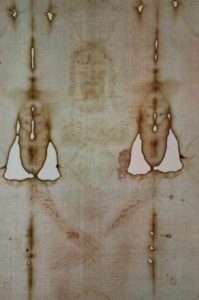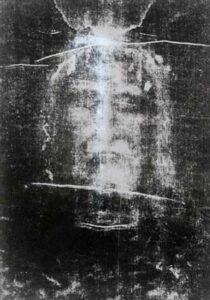 The Shroud of Turin is a centuries-old linen cloth that bears the image of a crucified man and is sometimes referred to as the most studied artifact in human history. Christ was buried in. It first appeared in France in 1357 and, ever since has prompted one of the greatest detective stories of all time. Is it really the burial shroud of Jesus Christ or simply a piece of ancient artwork? The Shroud of Turin, was painstakingly restored in 2002, measuring 4.4 by 1.1 metres (14.3 by 3.7 feet). No one has come up with a scientific explanation for the image, and no one has managed to replicate it. A section missing from the upper right-hand corner of the fabric was used for radiocarbon dating analysis in 1988 when samples were sent to four different labs. The analysis determined that the fibers in the cloth date from the Middle Ages, sometime between 1260 and 1390.
The Shroud of Turin is a centuries-old linen cloth that bears the image of a crucified man and is sometimes referred to as the most studied artifact in human history. Christ was buried in. It first appeared in France in 1357 and, ever since has prompted one of the greatest detective stories of all time. Is it really the burial shroud of Jesus Christ or simply a piece of ancient artwork? The Shroud of Turin, was painstakingly restored in 2002, measuring 4.4 by 1.1 metres (14.3 by 3.7 feet). No one has come up with a scientific explanation for the image, and no one has managed to replicate it. A section missing from the upper right-hand corner of the fabric was used for radiocarbon dating analysis in 1988 when samples were sent to four different labs. The analysis determined that the fibers in the cloth date from the Middle Ages, sometime between 1260 and 1390.
Barrie Schwortz, the official documenting photographer for the Shroud of Turin Research Project (STURP), says, “It took 17 years after we finished our examination of the Shroud and published all of our work before my questions were answered, and I had to accept that it was most likely authentic.” Many believe it to be the burial cloth of Jesus Christ, though skeptics are critical of its authenticity. Schwortz, who was invited to join the research team as a photographer in 1978, was a doubter in the beginning. After 45 years of examining it up close, the 77-year-old Jew from Colorado tells EastIdahoNews.com he’s now convinced it’s the actual cloth
 Research published by the National Agency for New Technologies, Energy and Sustainable Economic Development states that the image on the shroud, thought to be an imprint of Christ’s face, could only have been made by ultraviolet lasers. As lasers did not exist in either biblical or medieval times, researchers from the National Agency for New Technologies, Energy and Sustainable Economic Development are pointing towards some form of supernatural involvement.
Research published by the National Agency for New Technologies, Energy and Sustainable Economic Development states that the image on the shroud, thought to be an imprint of Christ’s face, could only have been made by ultraviolet lasers. As lasers did not exist in either biblical or medieval times, researchers from the National Agency for New Technologies, Energy and Sustainable Economic Development are pointing towards some form of supernatural involvement.By looking to identify “the physical and chemical processes capable of generating a color similar to that of the image on the shroud,” the study found that only ultraviolet lasers could create similar markings, concluding that some form of “electromagnetic energy (such as a flash of light at short wavelength),” was responsible.
The unsolved mystery behind the Shroud Of Turin still has the power to captivate as more data is being revealed.
